Amazing Environment Mind Map Collection
Create Your Environment Mind Map NowAmazing Environment Mind Map Collection
Everybody knows that global warming is real and that it’s happening at a rapid pace. Yet, we struggle with ourselves when it comes to making a decision that may benefit the environment in the long run. The real problem is uncertainty about where to start. Well, one way to get started is to build an environment mind map. It is a diagram with a particular action, idea, or concept at its core, which further branches out to associated activities, thoughts, and ideas. It is a great visual tool perfect for ascertaining where you stand and what you can do to go completely green.
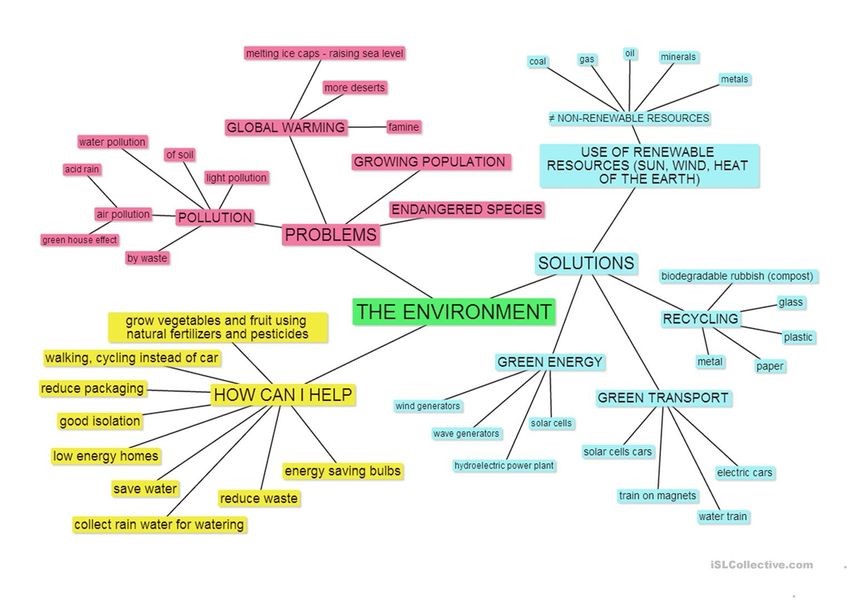
Image Source:islcollective.com
What are types of environment?
The word “environment” may seem like a rather casual and frequently used word, but it encapsulates the entire natural world. It includes and sustains a multitude of ecosystems, both big and small.
- Marine ecosystems: Considering 70% of the surface of our planet is water, and it comes as no surprise that the marine ecosystem is probably the most abundant, life-sustaining ecosystem on our planet. It shelters and supports an estimated 228,450 documented and over 2 million undocumented species of marine flora and fauna.
- Freshwater ecosystems: Freshwater ecosystems are the same as marine ecosystems. However, they are a separate ecosystem as the water itself is not saline, and flora and fauna differ from that of saltwater ecosystems.
- Forest ecosystems: The diverse flora and fauna that inhabit the forested areas of the seven continents are forest ecosystems. They get categorized based on their latitudinal location and the type of vegetation that they support.
- Desert ecosystems: Regions that receive less than 10 inches of rainfall annually are called desert ecosystems. They are bound together by their windy, arid, and sparse landscape. Flora and fauna in such ecosystems have adapted to their environment and are usually never found anywhere else.
- Tundra ecosystems: The cold, barren swaths of the landscape with perennially frozen permafrost are known as Tundra ecosystems. Like the desert ecosystems, vegetation is sparse, and they mostly grow when the snow melts during the spring and summer. Animals highly adapted to these extreme climatic conditions thrive here.
- Grassland ecosystems: The vast sweeping grasslands known as steppes, savannah, and prairie are collectively known as grassland ecosystems. Such areas receive low rainfall. Trees are sparse and even non-existent in certain areas.
Environment Mind Map Examples
Let us now analyze a few sound samples where mind maps help you identify

This environment mind map takes air pollution as its central concept and tries to analyze the impact of sprawling urbanization on the air quality of that region. The increase in urban settlements results in higher air-pollution and driving-related hazards. The consequences of sprawling urban areas range from cardio-pulmonary diseases and cancer to other conditions related to long term exposure, like infertility.
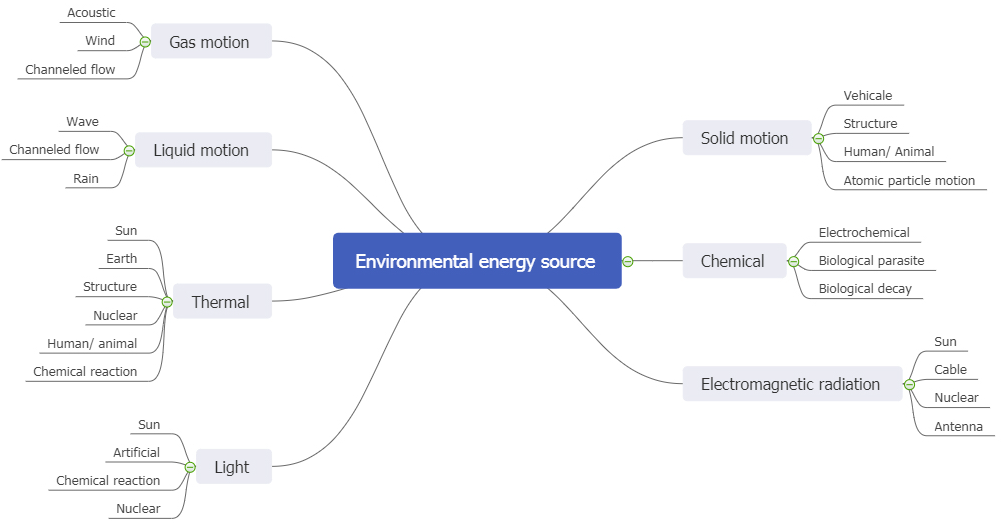
Two-thirds of the global greenhouse gas emission gets attributed to the consumption and generation of energy. Now we should start looking at alternative energy sources that are both sustainable and green. Apart from the known alternative sources of energy like solar, wind, and nuclear power, in this environment mind map, we can find innovative ideas like a chemical reaction and thermal heat.

Backyard burning as a practice is probably as old as civilization itself. But today they are a significant contributor to air pollution and greenhouse emissions. The density of particulates in the air increases due to backyard burning and prolonged exposure can lead to cardio-pulmonary severe diseases. Finding alternative solutions to convert this biomass into other useful products is the way of the future. Bio-diesel is one such innovative by-product of this recent shift in thinking.
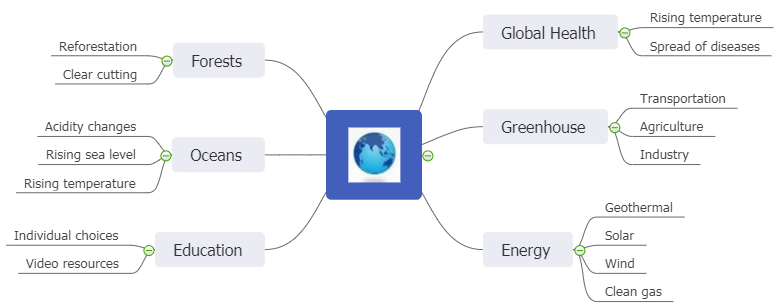
Climatic change is a broad subject with numerous contributors and an equally high number of consequences. The contributing factors may range from improper garbage disposal to excessive greenhouse gas emissions. While the effects range from medical and health issues to extinction of certain species of flora and fauna. Preventive measures like embracing green technology and education are a step towards the right path.
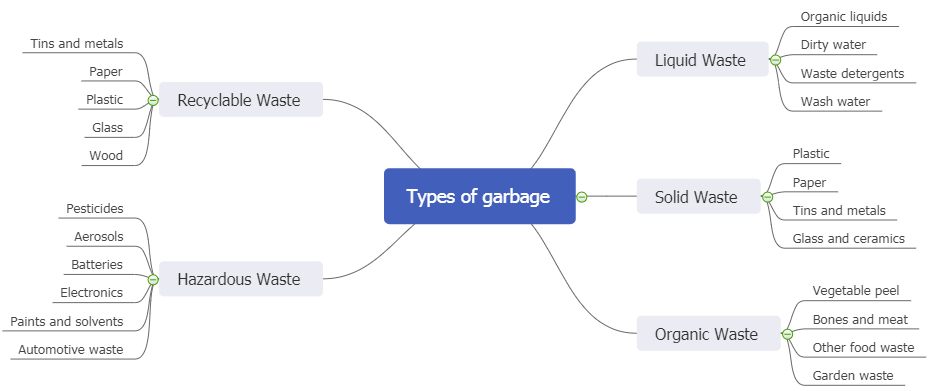
Reduce your carbon footprint or greenhouse gas emissions from your home. An excellent way to start is by managing your domestic waste and its disposal thereof. As we see in the environment mind map above, you can classify domestic waste into five categories: liquid, solid, organic, recyclable, and hazardous. Once you have identified the nature of the garbage generated in your household, you can proceed towards its disposal.
The interdependence of living and non-living organisms on each other for nutrition and energy in a specified environment is called an Ecosystem. In this environment mind map, we look at the various interdependencies and cycles in an ecosystem. It is a symbiotic relationship where organisms and their environments always engage with each other in an intricate exchange of energy and nutrients. It not only provides them with sustenance but also creates a cyclic effect, which affects the overall environment at a much bigger scale.
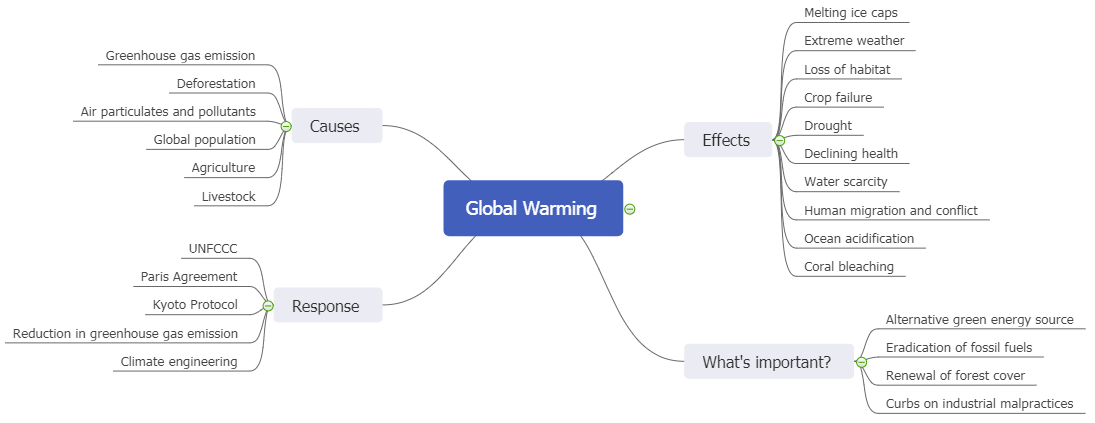
Let’s have a look at the environment mind map above. Renewing the lost forest cover ensures some delay in the global warming process. If nothing else, this one single step should buy us enough time to research alternative sources of energy and look forward to a better future.

The minute you decide to carry your shopping bag, you have already decided to say no to plastic. It’s a minuscule step, no doubt, nonetheless, in the right direction. Small actions like this accumulate to make a significant impact in the long run.
How to protect our environment
Now, let’s build an environment mind map to see what we can do to protect our environment.
The first thing should be the central idea, which in this case, is our environment. The next thing to consider is the various factors that influence it and are influenced by it.
Step 1: Go to the MindMaster website https://edrawmind.com/, register and log in to reach the home page.
Step 2: Now, select the type of mind map template that best fits your needs.
Step 3: Once done, you will get redirected to the work-page. The work-page displays a text box to enter your central concept by default. You can type in your idea by clicking on the text box.
Step 4: Use the toolbar on the top to insert the related topics and sub-topics or to insert images, comments, relationships, hyperlinks, and complete summaries.
Step 5: The toolbar on the right shows you the topic formats, where you can change the theme, layout, form, color, shapes, and connector style or choose from an array of clipart and outlines for your topics.
Step 6: Once you create your environment mind map, save it online by clicking on the Save as icon located at the top right corner of the page. To download a copy, click on Export on the same panel.
You can save the project as an image, as a PDF file, or print it out.
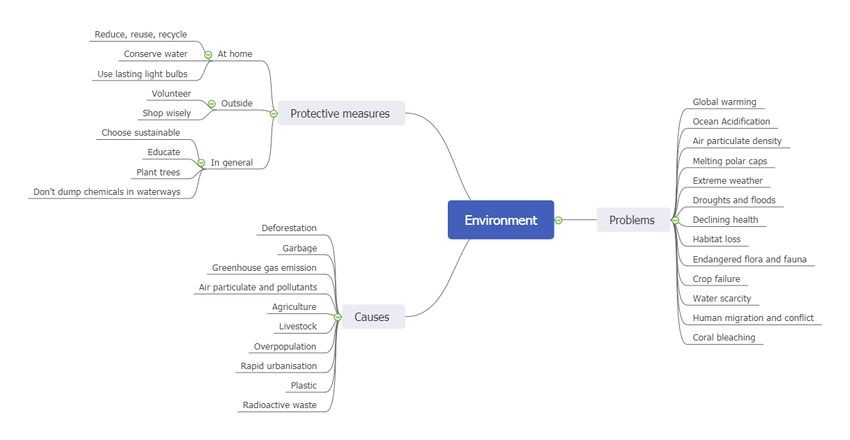
In this case, we took the causes and effects of global warming into account. Now the whole idea behind this mind map is to identify a few preventive measures to delay global warming. So the protective measures section outlines everything you can do in your day to day life and make a difference.